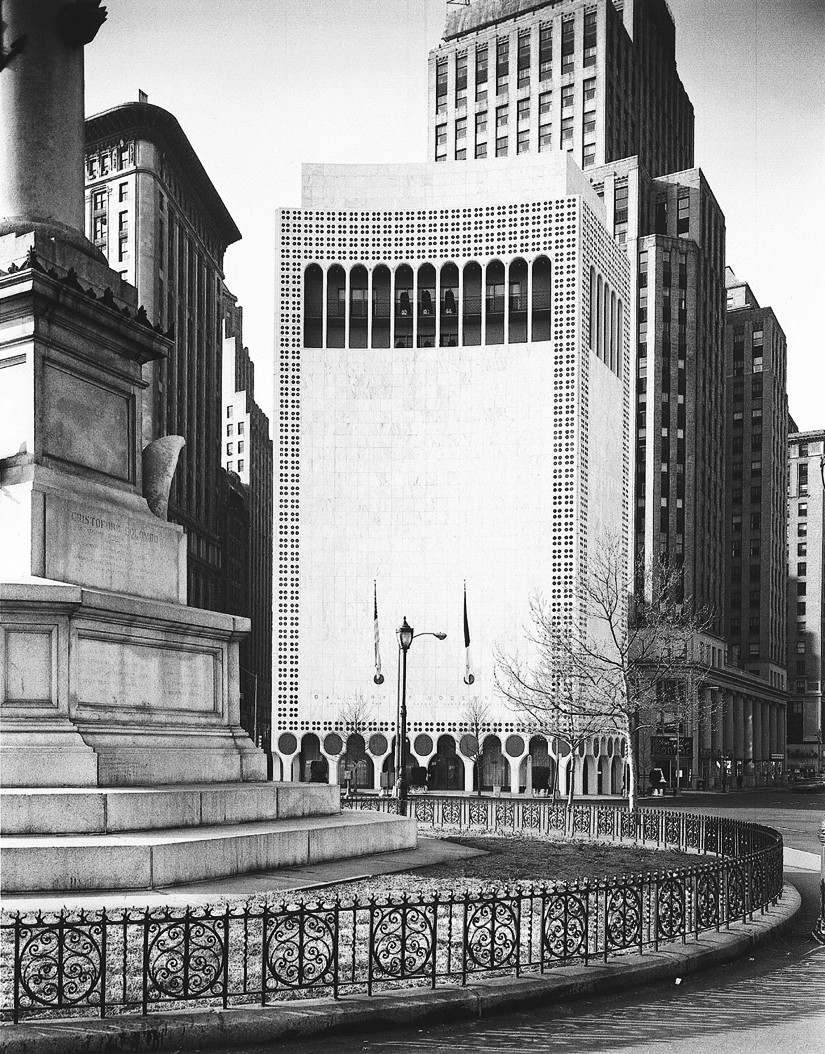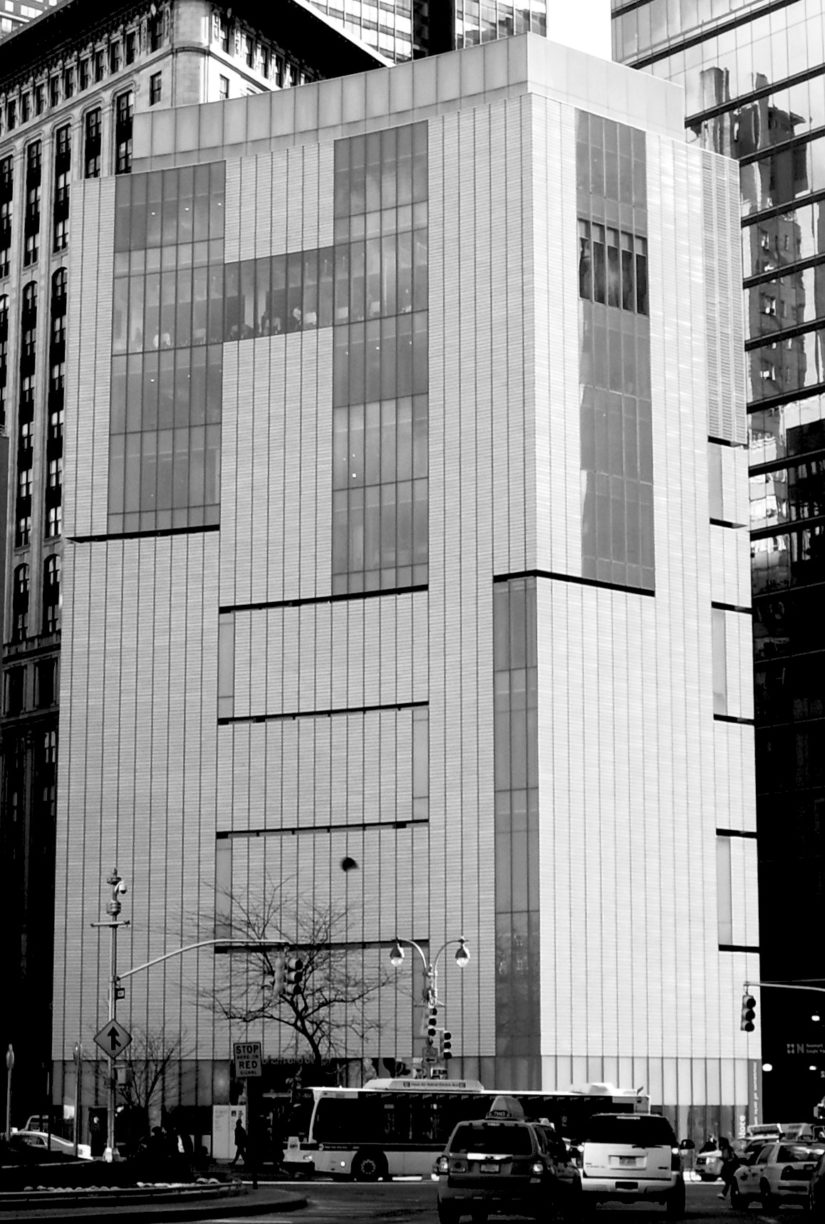
2 Columbus Circle
Designed in 1964 by Edward Durell Stone, 2 Columbus Circle was the center of a heated preservation battle when the building was converted into the Museum of Arts and Design in 2006.
2 Columbus Circle opened in 1964 as the Gallery of Modern Art. It was built by Huntington Hartford, heir to the A&P supermarket fortune, to house his own art collection and serve as a bulwark in his passionate fight against abstract art. The architect Edward Durell Stone designed this building for the Gallery of Modern Art.1 It was designed in the romantic modernist style, and boasted marble cladding, Venetian motifs, and a curved facade.2 Ada Louise Huxtable, then the architecture critic of The New York Times, memorably characterized the structure as resembling “a die-cut Venetian palazzo on lollipops.3 In 1969, the museum was given to Fairleigh Dickinson University and converted into the New York Cultural Center, with the purpose of “present[ing] the contributions of all races.” Fairleigh Dickinson University ran the building until 1975 and held many art exhibitions.
In 1980, the Gulf & Western Foundation deeded 2 Columbus Circle as a gift to the City of New York, on the condition that the City used the building solely as “its principal public facility for visitors’ services and cultural affairs.” The City used it as a visitors’ center and headquarters for the Department of Cultural Affairs until the agency moved out in 1998; the space then remained vacant until 2006, when the structure was redesigned and converted into the Museum of Arts and Design.4
2 Columbus Circle was converted into the Museum of Arts and Design in 2006. Brad Cloepfil of Allied Works Architecture redesigned this structure with a new facade. The building reopened in 2008.
June 1996: A four-member committee of the New York City Landmarks Preservation Commission determines that 2 Columbus Circle did not have enough historical or architectural significance to have a hearing to discuss its eligibility for landmark designation.
April 14, 2000: The New York Landmarks Conservancy, Historic Districts Council, and the Municipal Art Society co-sponsor a rally in front of 2 Columbus Circle to raise awareness for its preservation.
November 24, 2003: The Preservation League of New York State lists the structure on its "Seven to Save" register.
May 2004: Landmark West! launches a "Save 2 Columbus Circle" website.
May 24, 2004: The National Trust for Historic Preservation adds 2 Columbus Circle to the list of America’s 11 Most Endangered Historic Places.
June 21, 2005: The building is placed on World Monuments Fund's Watch List of "100 Most Endangered Historic Places" list.
October 2005: Landmark West! mounts the 2 Columbus Circle "ShameCam," a webcam positioned in an apartment window at 25 Central Park West with a view south towards 2 Columbus Circle, to document the scaffolding going up around the building.
2006: 2 Columbus Circle is redesigned with a new facade by Brad Cloepfil of Allied Works Architecture and converted into the Museum of Arts and Design.
The future preservation of 2 Columbus Circle was first threatened in June 1996, when a four-member designation committee (composed of Reverend Thomas F. Pike, Professor Sarah Bradford Landau, Charles Sachs, and Vicki Match Suna) on the New York City Landmarks Preservation Commission decided that 2 Columbus Circle did not possess enough architectural or historical significance to warrant a public hearing to discuss the building's potential for landmark designation.5 As a result of this decision, in the years that followed, many preservation and civic-minded organizations launched campaigns to oppose the redesign of 2 Columbus Circle, and to rally for landmark designation of the structure. These groups appealed to the Commission, organized rallies, petitions, and letter writing campaigns. The press covered the preservation battle extensively.6
By March 7, 2000, the Committee for Environmentally Sound Development, a neighborhood group, led a preservation charge to try and preserve 2 Columbus Circle.7 Then, on April 14, 2000, the New York Landmarks Conservancy, Historic Districts Council, and the Municipal Art Society co-sponsored a rally in front of 2 Columbus Circle to raise awareness for its preservation.8
By 2003, the preservation efforts to save 2 Columbus Circle greatly increased. From October 12-13, 2003, The New York Times printed a 2-part, 2300-word Op-Ed piece on 2 Columbus Circle by Tom Wolfe, in which he argued the significance of Edward Durell Stone as an architect and 2 Columbus Circle as an architecturally significant building.9 Then on November 24, 2003, the Preservation League of New York State listed the structure on its "Seven to Save" register.10
Landmark West! also played a role in this preservation effort. On June 4, 2003 they wrote to Landmarks Preservation Commission Chair Robert Tierney, reinforcing the fact that both the National Trust for Historic Preservation and the Preservation League of New York State had sent him letters calling for a public hearing on 2 Columbus Circle. The letter quoted the famous 1963 New York Times editorial on the destruction of Pennsylvania Station: "We will probably be judged not by the monuments we build but by those we have destroyed." The letter also invoked what would become a catch phrase for the 2 Columbus Circle campaign "What more will it take?"11
On June 30, 2003, the Municipal Art Society also got involved with this effort, when they wrote a letter to Commission Chair Robert B. Tierney, and stated that a "new understanding of the building’s significance in the history of 20th century architecture in America had inspired the Society’s Preservation Committee to re-examine its long-held position. The Committee determined last week that the building is not only deserving of a landmark designation hearing; it is the opinion of the Committee that the building should be designated a New York City landmark."12 In addition, the Modern Architecture Working Group joined the effort to get a public hearing for 2 Columbus Circle.13
By May 2004, Landmark West! continued its preservation effort to save 2 Columbus Circle by launching a "Save 2 Columbus Circle" website and sending out thousands of fundraising letters, introducing the Save 2 Columbus Circle logo.14 However, this did not end the threat to the building. On May 24, 2004, the National Trust for Historic Preservation added 2 Columbus Circle to the list of America’s 11 Most Endangered Historic Places.15
Then in May 2005, Landmark West! hired the Advance Group, a government relations firm, and Source Communications, a public relations firm, to work on getting the Landmarks Preservation Commission to hold a public hearing on 2 Columbus Circle.16 However, the threat to 2 Columbus Circle still lingered, as on June 21, 2005, the building was placed on World Monuments Fund's Watch List of "100 Most Endangered Historic Places" list.17
As the date set to convert the building into the new Museum of Arts and Design approached, several commissioners of the Landmarks Preservation Commission joined the fight to have a hearing on the topic.18 Despite this, it did not prevent scaffolding from starting to go up around the building on October 8, 2005. Soon after, Landmark West! mounted the 2 Columbus Circle "ShameCam," a webcam positioned in an apartment window at 25 Central Park West with a view south towards 2 Columbus Circle. The "ShameCam" stayed in operation until a new building under construction at 15 Central Park West blocked its view.19
Then, the New York Chapter of the American Institute of Architects collaborated with Landmark West! in the effort to obtain a public hearing for 2 Columbus Circle.20 Despite these efforts, it did not prevent Edward Durell Stone's 2 Columbus Circle from getting redesigned with a new facade in 2006 by Brad Cloepfil of Allied Works Architecture, and converted into the Museum of Arts and Design.21
In the end, the effort to preserve 2 Columbus Circle was significant. Many have drawn comparisons between the 2 Columbus Circle controversy and the historic demolition of Pennsylvania Station. The preservation battle involving 2 Columbus Circle has awoken preservation interests to the continuous threat to historically and architecturally significant structures. Preservation forces have been reminded that landmarks legislation is only as effective as its implementation, and many have begun to closely consider the losses that have occurred as a result.22 The 2 Columbus Circle campaign was also one of the first preservation battles to embrace and fully utilize modern technology in its advocacy efforts.
In 2007, the New York Preservation Archive Project undertook a documentation project focused on the 10-year, grassroots-led advocacy campaign to preserve 2 Columbus Circle. This project is meant to provide preservationists and future historians with a primary resource to help them identify key elements of the campaign. Kate Wood, Executive Director of Landmark West!, a leader and close inside observer of the campaign constructed a timeline for significant events associated with the building and the campaign to save it. Much of the focus of this work is aimed at assisting others in extracting lessons for preservation campaigns to come. Please contact the New York Preservation Archive Project for more information on this project.

- Municipal Art Society Records, Archives of American Art
1285 Avenue of the Americas, Lobby Level
New York, NY 10019 - Oral History with Laurie Beckelman, Mosette Broderick, Sherida Paulsen, Jack Taylor
- New York Preservation Archive Project
- 174 East 80th Street
- New York, NY 10075
- Tel: (212) 988-8379
- Email: info@nypap.org
- David Dunlap, “For 2 Columbus Circle, a Growing Fan Club,” The New York Times, 18 August 2005.
- “2 Columbus Circle: former Gallery of Modern Art,” New York Architecture, 22 January 2016.
- David Dunlap, “For 2 Columbus Circle, a Growing Fan Club,” The New York Times, 18 August 2005.
- Kate Wood, “The Campaign to Preserve 2 Columbus Circle: A Chronology,” New York Preservation Archive Project, 2007.
-
David Dunlap, “For 2 Columbus Circle, a Growing Fan Club,” The New York Times, 18 August 2005.
-
Kate Wood, “The Campaign to Preserve 2 Columbus Circle: A Chronology,” New York Preservation Archive Project, 2007.
-
David Dunlap, “On Columbus Circle, Hints of an End to an Enigma,” The New York Times, 7 March 2000.
-
Daniel J. Wakin, “Effort to Preserve a Monolith,” The New York Times, 14 April 2000.
-
Tom Wolfe, “The Building That Isn’t There,” The New York Times, 12-13 October 2003.
-
Kate Wood, “The Campaign to Preserve 2 Columbus Circle: A Chronology,” New York Preservation Archive Project, 2007.
-
Kate Wood, “The Campaign to Preserve 2 Columbus Circle: A Chronology,” New York Preservation Archive Project, 2007.
-
Ibid.
-
National Trust’s Press Release, 24 May 2004.
-
Kate Wood, “The Campaign to Preserve 2 Columbus Circle: A Chronology,” New York Preservation Archive Project, 2007.
-
World Monuments Fund Press Release, 21 June 2005.
-
David Dunlap, “For 2 Columbus Circle, a Growing Fan Club,” The New York Times, 18 August 2005.
-
Kate Wood, “The Campaign to Preserve 2 Columbus Circle: A Chronology,” New York Preservation Archive Project, 2007.
-
Ibid.
-
“The New 2 Columbus Circle,” Gothamist, 2 May 2008.
-
Anthony C. Wood, Preserving New York: Winning the Right to Protect A City’s Landmarks (New York: Routledge, 2007), page 375.
-
Preservation League of New York Press Release, 24 November 2003.
-
Municipal Art Society letter to Robert Tierney, June 30, 2003.